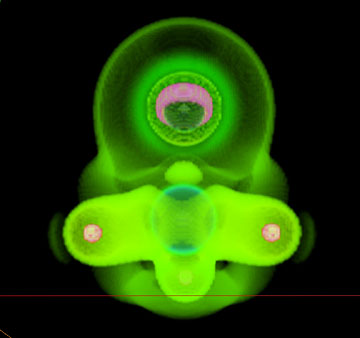 by Preston MacDougall August 21, 2006
Nowadays, via the internet, bloggers tell us all about an ongoing conference in Prague, where astronomy scholars are debating how many planets orbit our sun. At a meeting of the International Astronomers Union being held in the Czech capital, there are passionate supporters for popular answers such as "8", "9", and "12", as well as some authoritative voices positing "53 and counting".
Based on some of the questions that are popping up in my browser, I'm not sure what the bloggers are burning. Consider what Paul the Hermit has to say: "If Mickey Mouse's dog can have one (a planet named for him), why can't I?" Paul the Hermit's question,
and most of the controversy surrounding counting planets, revolves
around Pluto, the 9th planet to be discovered in our solar system.
This discovery was made in Flagstaff, Arizona, by Clyde Tombaugh,
in 1930. New observatories have been built on the Mars Hill site, and are still active in astronomical research, but the original observatory is now a museum open to the public. It effectively conveys the laborious task undertaken by Tombaugh, who did not obtain his degrees in astronomy until after his greatest discovery. I recommend a visit if you are in the neighborhood. If your timing is right, you can get a close-up look at a canyon (on Mars) that is even bigger than the one to the North. While Neptune's "irregularities" were only evident mathematically, once found by Tombaugh, Planet X was a material reality. The name of Pluto was soon accepted, but the same cannot be said for its planetary status. It is smaller than all the others, and orbits the sun on an imaginary plane that is significantly inclined relative to those of the other eight planets. There have always been 9th planet skeptics. By my nature, I was inclined to join them as soon as I started studying the solar system as a student. My visit to Mars Hill, as impressive as it was, did nothing to change this opinion. Nor does the blogging from Prague. In the August 16th issue of the New York Times, science reporter Dennis Overbye summarized some of the competing resolutions among conferees. These include lumping Pluto and other large, round, solar-powered revolvers beyond Neptune, into a category called Plutons. They would still be planets, but not "classical planets", of which there would be only eight. Bottom-liners may be thinking to themselves: "Star gazers by night, navel gazers by day. The question itself is ridiculous." Scientists will differ on the best answer to the question, and even whether or not the answer has any significance. But, most, if not all, scientists would agree that it is important to classify planet-like objects in some way. It is only through measurement and classification that regularities (or irregularities) in the natural world become apparent. Since our sun is only one of the stars in the Milky Way Galaxy, which is but a single member of the universe's legion of galactic bodies, the "natural world" extends far beyond our solar system. Have you ever gazed upon a star, wondering how many planets there are? The question becomes much more interesting when you omit the "in our solar system" part. Observational and mathematical methods analogous to those used by Tombaugh are returning ever more detailed evidence of planetary objects revolving around other stars. Systematic, and agreed-upon methods of classifying such objects may one day lead to an understanding of the requirements for Earth-sized planets. This would focus the scanning for Earth-like planets themselves, which is currently like searching for a needle (with or without standing angels) in a haystack. While scientists are a revisionist mood, maybe they could address the more down-to-Earth question of "Why do Europe and Asia count as two continents?"
On the Web:
Publish A Letter on SitNews Read Letters/Opinions Submit A Letter to the Editor
|
||
